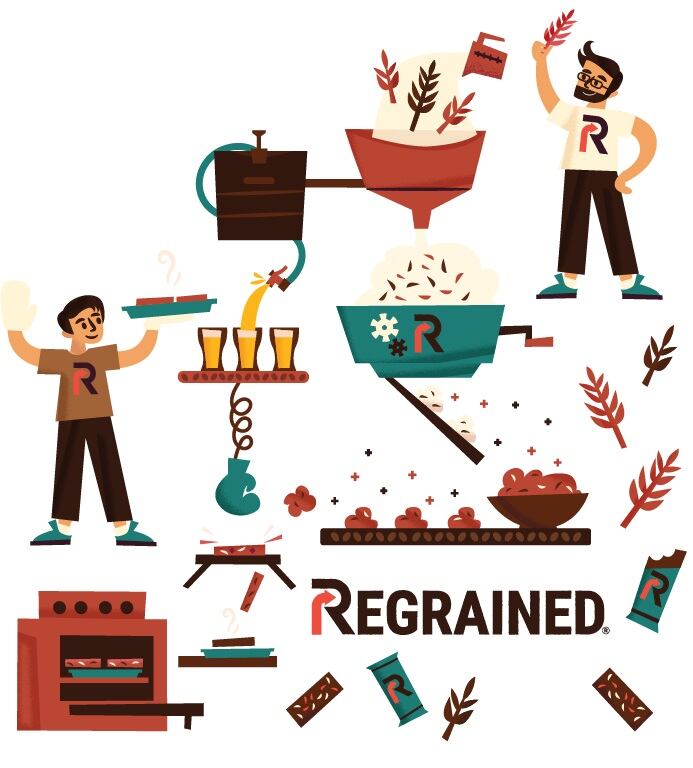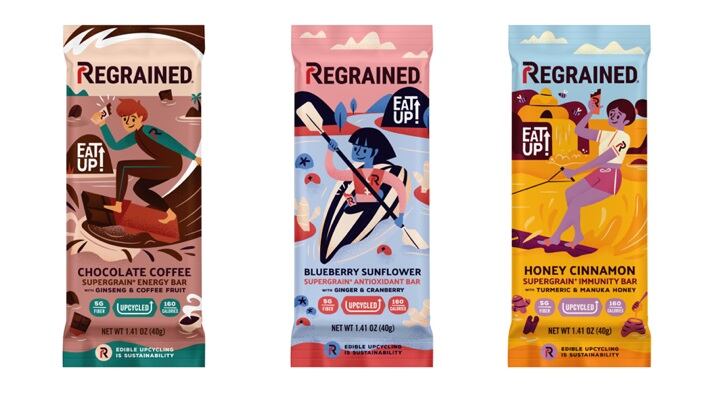Beginning Aug. 25, ReGrained will ship its snack bars made from “spent grain” used to brew beer, in colorful new wrappers featuring illustrations and cartoons of people kayaking, surfing and water skiing while eating the company’s bars to fuel their fun.
“We wanted to make something that is frankly more fun and delicious looking,” than the current text-heavy packaging that relies on health claims and a large window to sell the product, Dan Kurzrock, co-founder and chief grain officer for ReGrained, told FoodNavigator-USA.
He explained that the new “illustrated style of the packaging is very different from what we are seeing on the shelf … and we liked the idea of using illustrations and cartoons that we can animate to create this identify that is whimsical.”
At the same time, he adds, the new packaging’s tagline, “Eat up!” with a stylized arrow as the exclamation point strives to better educate consumers about the company’s sustainability mission to reduce food waste by upcycling grain used to brew beer that otherwise would end up in a landfill. The tagline also plays on the phrase ‘eat up,’ which means to finish your food because it is good for you, Kurzrock said.
Also hidden throughout the new packaging is a stylized capital letter R that incorporates another upward pointing arrow. The new logo also is part of a seal ReGrained created to appear on other manufacturers’ products that use the company’s upcycled ingredient.
“As ReGrained transitions from a snack company into a more fully realized ingredient platform, we need an identity that will play across categories and across brands,” so that when other companies use ReGrained+ flour the startup will receive credit and it hopefully will generate interest from other industry players and consumers, Kurzrock said.
Fewer claims for greater impact
To make room for the whimsy and fun to come through in the new design, ReGrained also pared back several of the claims on the front of the pack so that the ones remained would have more impact.
Among the call-outs on the old packaging that didn’t make the cut was the amount of sugar in each serving. Kurzrock explained that while sugar is a top consumer concern, many didn’t understand that the 8 grams in a ReGrained bar was significantly less than the 14-28 grams in many competing products. Rather, most consumers thought the amount of sugar was still a lot and the claim became a deterrent.
The brand also skipped the call-out for protein, but kept the one for fiber, which Kurzrock said is a better point of differentiation for the brand compared to competitors.

“There is a lot of focus on protein today … but from an actual nutritional standpoint there are not as many problems with protein deficiency as there are with fiber deficiency. Almost nobody is getting enough fiber and our products qualify as a good source of fiber and also have prebiotics to support digestive health,” he said.
He added that even though the bars meet FDA’s standard for a qualified health claim about the benefits of fiber, it decided to simply state the amount per serving rather than make the full claim to avoid cluttering the package with qualifying language.
Finally, Kurzrock said, the call-out for calories remained on the new packaging because they are lower than most competitors – making it a key differentiator.
Tackling past mistakes
Kurzrock said he also hopes the new look will signal to consumers that the brand has addressed previous packaging problems that compromised taste and experience.
He explained that from the beginning the brand wanted to use compostable packaging for its snack bars so that while in the process of reducing food waste it wasn’t also creating waste from single-use packaging.
However, while the compostable packaging worked well on a small scale, as the company expanded distribution it discovered the moisture barrier was insufficient protection against temperature changes experienced in transit, resulting in bars produced the prior week or month tasting stale when they arrived at the store.
“The packaging choice was well intentioned,” but was “experimental and unfortunately, that came at a cost, and now we are slowing down to speed-up,” Kurzrock said.
He explained that the company quickly switched to conventional wrappers in April to address the problem, but unless consumers read the brand’s blog they wouldn’t know there was a change because the new packaging looked identical to the previous faulty wrappers.
With the new look, Kurzrock said he hoped to reintroduce the brand to consumers and show them how great the bars can taste.
“We are still super optimistic about [using compostable packaging] and committed to using it” again in the future once it finds a material that will sufficiently protect the product, he said. “We have got some new next-generation materials we are testing and we hope within a year to be back in compostable.”
In preparation for that, Kurzrock said, the brand also dropped the window that dominated its previous packaging. He explained that the new compostable packaging likely will need a metalized layer to protect the product from oxygen or losing moisture, and that obviously, won’t be see through. This way the company won’t need to undergo another redesign when it transitions back to plant-based compostable material.
While Kurzrock said the problems with the previous packaging were a “nightmare,” he said developing the new branding and “reimagining how ReGrained could be portrayed to the world” was “really a lot of fun,” and that he is “excited to get these elements out there and to keep the conversation moving forward about the power of upcycling.”

